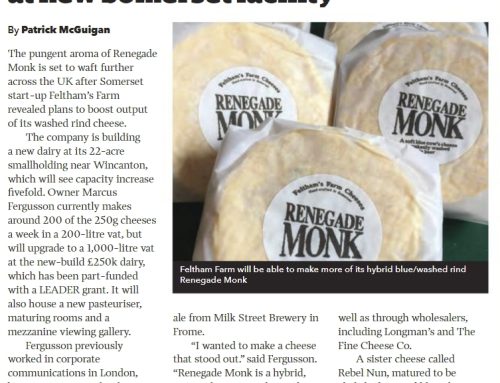I’m rapidly learning how precise a science cheesemaking is. Unless you’re processing hundreds or thousands of litres of milk (which I am not), the quantities of required additives such as starter culture or rennet are at once tiny and exact. The same goes for the salting.
Salt has to be added to cheese for several reasons. The first is to slow and stop the acidification of the cheese (I’ll cover the general principles of cheesemaking in a later post when I do my first domestic make). The salt also helps to draw more whey out of the cheese and it helps to protect the outside of the cheese by preventing bacteria and mould from forming on the surface. Lastly, it influences the flavour – through the salt itself and by helping to develop other flavours.
Paul Thomas’ instructions for my Camembert are to wait for 24 hours from the beginning of the make. By this stage the pH of the cheese should have dropped to around 4.80 (fresh cow’s milk typically starts at about 6.60). I had no way of telling whether my cheeses had fallen to the correct pH as I do not yet have a pH meter but I have to assume that they are ready to go.
The instructions are to unmould the cheeses and weigh them. They will then require 1.8% w/w of salt. My cheeses all weigh around 160g so this means that each cheese needs 2.88g of salt – or 1.44g per side.
The only thing I have that can weigh that sort of quantity is a dodgy old set of drug dealers scales (they were a prop for something I filmed on The F Word, honest). So, having measured out what approximates to 1.44g, I set about carefully sprinkling the salt onto the surface of the cheese. It’s a slow process but maybe I was being overly careful on my first make. Anyway, I will have to invest in a set of digital microscales.
The cheeses are then covered with a plastic Tupperware box to maintain humidity and ideally need to be kept at between 20-25˚C. The best place then, it seemed to me, was next to the boiler. Six hours later, I turned and salted the other side of the cheese – then it was back under the box next to the boiler for a further 24 hours.
After that, the cheeses need to mature at around 10-15˚C, still under the box for two to four weeks. We don’t have a larder but we do have an old fridge that doesn’t work very well so it’s warm enough for my purposes. In they went – and I will be turning them every two days, hopefully watching the characteristic white mould form on the surface.



